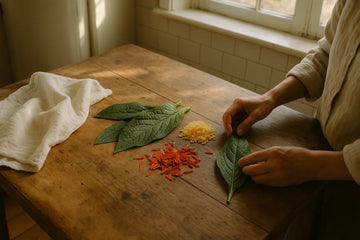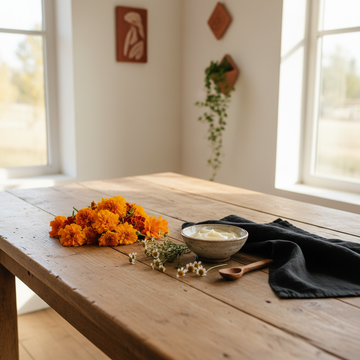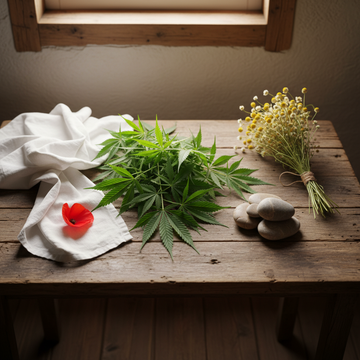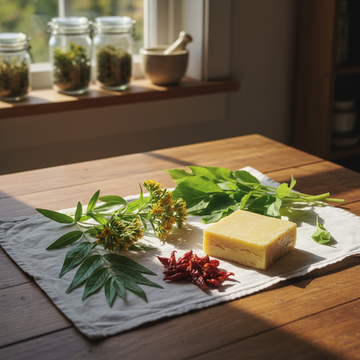Nature has provided us with proven remedies for centuries – and comfrey ointment is at the top of the list of traditional home remedies for sports injuries, joint pain, and skin problems. As Jiri Studnicky of H4H Naturals, who learned the art of herbal medicine from his 102-year-old pharmacist grandmother, I can confirm: Symphytum officinale (comfrey) is far more than just an old home remedy – modern research proves its impressive effectiveness.
Key Takeaways
- Comfrey ointment is a traditional home remedy for treating sports injuries, joint pain, and skin problems.
- Jiri Studnicky of H4H Naturals learned herbal medicine from his 102-year-old pharmacist grandmother.
- Symphytum officinale, also known as comfrey, has a long history as a medicinal plant.
- Modern research confirms the impressive effectiveness of comfrey ointment.
Table of Contents
- What is comfrey and why is it so effective?
- Scientific evidence: How effective is comfrey ointment really?
- Safety and Pyrrolizidine Alkaloids: What You Need to Know
- Comfrey as a home remedy: traditional wisdom meets modern science
- Step-by-step instructions: Make your own comfrey ointment
- Comfrey Gel: The light alternative to the classic ointment
- Quality control and shelf life of your homemade comfrey ointment
- Naturally relieve comfrey: Professional application tips
- Sustainability and environmental aspects of DIY
- Advanced combinations and synergies with other medicinal plants
- Modern extraction methods for maximum effectiveness
- Skin type-specific adjustments to your comfrey ointment
- When to choose professional products
- Integration into holistic treatment concepts
- The future of comfrey use
At a time when more and more people are looking for natural alternatives to synthetic painkillers, comfrey ointment is experiencing a renaissance. But what makes this unassuming plant so special? And how can you make your own high-quality organic ointment in 2025 that is both effective and environmentally friendly?
Short answer
Comfrey ointment is a traditional home remedy made from the root or leaves of the common comfrey (Symphytum officinale), which is rich in healing allantoin and anti-inflammatory rosmarinic acid. The ointment has been proven to help with bruises, sprains, strains, acute back pain, and osteoarthritis-related complaints. To make an organic comfrey ointment 2025, you will need dried comfrey root, organic carrier oil (olive oil or sunflower oil), beeswax, and optionally other healing plant extracts. Important: Use only externally on intact skin and ensure that you use pyrrolizidine alkaloid-reduced (PA-free) extracts.
What is comfrey and why is it so effective?
Common comfrey (Symphytum officinale) belongs to the Boraginaceae family and has been valued as a medicinal plant for over 2,000 years. The name "comfrey" is derived from the Old High German "beinwella," meaning "bone healer." This name is no coincidence, as the plant contains a unique combination of bioactive compounds that can accelerate healing processes.
The most important active ingredients in comfrey:
- Allantoin (0.6-4.7%) : Promotes cell regeneration and tissue repair
- Rosmarinic acid : Strong anti-inflammatory and antioxidant
- Mucilages : Soothe and protect the skin
- Tannins : Astringent and wound-healing
- Choline : Supports cell membrane functions
Based on our experience at H4H Naturals and current scientific findings, allantoin is particularly noteworthy. This compound stimulates the proliferation of fibroblasts—the cells responsible for collagen production and connective tissue repair. This is why comfrey ointment is so effective for sports injuries and joint pain.
Comfrey root vs. comfrey leaves: Which is better?
This is often confusing, but science provides a clear answer: In randomized clinical trials, comfrey root extracts show the most potent effects on pain and inflammation. The root contains higher concentrations of allantoin and other active compounds than the leaves.
Benefits of comfrey root
- Highest allantoin content (up to 4.7%)
- Best clinical evidence for pain relief
- Superior efficacy in acute back pain
- Longer shelf life in ointment form
Disadvantages of comfrey root
- More complex harvesting and processing
- Higher costs than leaf extracts
- Requires longer extraction times
Scientific evidence: How effective is comfrey ointment really?

As an evidence-based company, we at H4H Naturals place great importance on scientifically sound claims. The research on comfrey ointment is impressive: In a particularly significant randomized controlled trial, comfrey root cream demonstrated statistical superiority over diclofenac gel on various pain parameters – and this after just 4 days of use.
Study results: Patients with acute back pain reported significantly greater pain reduction with comfrey root treatment than with diclofenac gel. The difference was even more pronounced on day 7.
What ailments does comfrey best help with?
Clinical research and our experience with customers show that comfrey ointment is particularly effective for:
- Acute sports injuries : bruises, sprains, strains
- Back pain : Especially in acute, non-chronic cases
- Osteoarthritis-related joint pain : Improvement of pain and mobility
- Sore muscles and tension : After intensive training or physical work
- Mild skin irritations : On intact skin to soothe
Expert tip from Jiri: In my family, we have been using a combination of comfrey root and arnica for sports injuries for generations. The synergistic effect of both plants potentiates their healing properties—a principle we also implement in our H4H Naturals formulations.
Safety and Pyrrolizidine Alkaloids: What You Need to Know
An important issue that often causes uncertainty is the pyrrolizidine alkaloids (PAs) in comfrey. These natural compounds can have liver toxicity when used internally—therefore, modern comfrey ointment is intended exclusively for external use.
Modern safety standards for comfrey products:
- For external use only on intact skin
- Use PA-reduced or PA-free extracts
- Limited duration of use (max. 4-6 weeks per year)
- Do not use on open wounds or mucous membranes
- Caution during pregnancy, breastfeeding and children
At H4H Naturals, we work exclusively with certified organic suppliers who cultivate special comfrey cultivars with naturally lower PA levels. Additionally, we use gentle CO₂ extraction processes that selectively isolate the desired active ingredients and minimize problematic compounds.
Comfrey as a home remedy: traditional wisdom meets modern science

My grandmother, an experienced pharmacist who lived to be 102, taught me early on: "Jiri, nature gives us everything we need—we just have to learn to look." Her comfrey home remedy recipes still form the basis for many of our H4H Naturals formulations today.
Traditionally, comfrey was used in various forms:
- Comfrey compresses : Fresh leaves crushed and placed on injuries
- Comfrey tea for washing : Externally for skin cleansing and soothing
- Comfrey oil extracts : Roots soaked in olive oil for months of maceration
- Comfrey ointments : With lard or beeswax to give consistency
What our ancestors knew intuitively is now confirmed by science: The topical application of comfrey ointment can significantly accelerate healing processes and relieve pain – without the side effects of synthetic painkillers.
Comfrey ointment at a glance:
Main active ingredient: Allantoin (cell regenerating)
Application: Apply a thin layer 2-4 times daily
Onset of effect: First improvements after 2-4 days
Best evidence: Acute back pain, sports injuries
Safety: External use only, prefer PA-reduced extracts
In the next part of our comprehensive guide, we'll take a detailed look at how to make your own organic comfrey ointment, the ingredients and tools you'll need, and how to maintain the highest quality and safety standards. We'll also compare different preparation methods and show you how to make comfrey gel as a lighter alternative to the classic ointment.
Step-by-step instructions: Make your own comfrey ointment
After decades of experience in making herbal remedies, I can assure you: Making a high-quality comfrey ointment yourself is easier than you think – if you know the right techniques. The following instructions are based on my grandmother's tried-and-true methods, supplemented by modern quality and safety standards.
What you need for 100ml of organic comfrey ointment:
- 20g dried organic comfrey root (or 15g PA-reduced extract)
- 80ml cold-pressed organic olive oil (or sunflower oil)
- 12g organic beeswax (or vegetable candelilla wax)
- 5 drops of vitamin E oil (natural preservative)
- Optional: 3 drops of lavender oil for calming properties
Method 1: Classic oil maceration (recommended for beginners)
This traditional method gently extracts the valuable ingredients and is particularly sustainable because it does not require any electrical devices.
- Preparing the comfrey root: Grind the dried root into coarse pieces (not powder) using a mortar or coffee grinder.
- Creating an oil infusion: Place the chopped root in a clean screw-top jar and pour the organic oil over it completely.
- Maceration: Let the mixture steep in a warm, dark place for 2-4 weeks. Shake the jar daily.
- Strain: After the maceration period, strain through a fine-mesh sieve or cheesecloth and squeeze out the plant material.
- Prepare the ointment: Heat 80ml of comfrey oil in a water bath to 60°C and dissolve the beeswax in it.
- Filling: Remove from heat, stir in vitamin E oil and fill into sterilized jars.
Pro tip: Test the consistency by adding a drop to a cold spoon. The perfect comfrey ointment is spreadable, but not too soft.
Method 2: Fast heat extraction (for users in a hurry)
If you need your comfrey ointment more quickly, you can shorten the extraction time to 2-3 hours using controlled heat.
| Step | temperature | Length of time | Important instructions |
|---|---|---|---|
| Heat the oil mixture | 50-60°C | 2-3 hours | Keep temperature constant, do not overheat |
| Rest time | Room temperature | 30 minutes | Allow to draw for optimal extraction |
| Strain | Warm (40°C) | 10 minutes | Press through cheesecloth for maximum yield |
| Finish the ointment | 60°C | 5 minutes | Dissolve beeswax completely |
Expert tip from Jiri: For heat extraction, I like to use a sous vide device at exactly 55°C. This precise temperature control maximizes allantoin extraction without destroying heat-sensitive compounds.
Comfrey Gel: The light alternative to the classic ointment

For those who prefer a less greasy texture or want to apply the ointment under clothing, a comfrey gel is the perfect solution. This modern formulation absorbs faster and leaves no oily film. Those looking for a cooling, quickly absorbed skincare product will also find practical alternatives in high-quality cooling gels and pain creams containing comfrey and arnica.
Benefits of Comfrey Gel
- Absorbs quickly, no greasy film
- Cooling effect for acute injuries
- Ideal for hairy areas of the body
- Can be used well under clothing
- Fewer stains on textiles
Disadvantages of Comfrey Gel
- Shorter shelf life than ointments
- Less occlusive, therefore less penetration
- More complex production
- Requires additional preservation
Simple Comfrey Gel Recipe
For a high-quality comfrey gel, we use xanthan gum as a natural gelling agent – a sustainable replacement for synthetic polymers.
Ingredients for 100ml Comfrey Gel:
- 80ml comfrey hydrosol (or strong, cooled comfrey tea)
- 15ml comfrey oil extract (prepared according to the instructions above)
- 1.5g xanthan gum (organic quality)
- 3ml glycerin (for smoothness)
- 0.5ml benzyl alcohol (natural preservative)
- Stir in xanthan: Slowly sprinkle xanthan into the hydrosol, mixing vigorously with a hand blender.
- Incorporate the oil phase: Add comfrey oil extract and glycerin drop by drop while stirring constantly.
- Homogenize: Blend with a hand blender for 2-3 minutes until a uniform gel consistency is achieved.
- Preservation: Stir in benzyl alcohol and fill into sterilized tubes or dispensers.
Quality control and shelf life of your homemade comfrey ointment
As a company that adheres to the highest quality standards, I would like to share with you the most important checklists for your homemade comfrey ointment . This is the only way to ensure your product is as effective and safe as commercial preparations.
Quality criteria at a glance:
Color: Greenish to brownish (depending on the extraction method)
Consistency: Spreadable at room temperature, not too hard or too soft
Odor: Characteristic earthy-vegetable, not rancid
Shelf life of ointment: 12-18 months when stored in a cool, dark place
Gel shelf life: 6-9 months in the refrigerator
Recognize signs of quality loss
You should regularly check your homemade comfrey ointment for the following changes:
- Rancid smell: Indicates oxidation of the oils – discard the ointment
- Discoloration: Dark spots may indicate mold growth
- Changes in consistency: Too soft or crumbly due to temperature fluctuations
- Skin irritation: Stop use if unusual reactions occur
Naturally relieve comfrey: Professional application tips
Correct application is crucial to the success of your comfrey treatment . Based on clinical studies and our practical experience at H4H Naturals, the following protocols have proven particularly effective.
Optimal application: Apply a thin layer of comfrey ointment to the affected area 2-4 times daily. Gently massage it in until completely absorbed. The best effect is achieved with regular use for 5-7 days.
Special application protocols for various complaints
Depending on the type of complaint, you can optimize the application of your comfrey ointment :
Acute sports injuries (first 48 hours)
- Follow the PECH rule: Rest, Ice, Compression, Elevation
- After cooling: Apply comfrey ointment thinly, do not massage in
- Frequency: 3-4 times daily for maximum allantoin effect
- Combination: Can be fixed with elastic bandages
Chronic joint problems
- Morning: Thin layer before exercise
- After activity: More generous amount with gentle massage
- Evening: Intensive application before going to bed
- Treatment character: Use for 4-6 weeks, then pause
Sustainability and environmental aspects of DIY
As a member of "1% for the Planet," we at H4H Naturals are passionate about protecting the environment. With our homemade comfrey ointment, you can also contribute to environmental protection and save money at the same time.
Environmental impact: A homemade 100ml comfrey ointment saves an average of 15g of plastic packaging and 40% CO₂ emissions compared to ready-made products due to the elimination of transport routes.
Sustainable sourcing of ingredients
For a truly environmentally friendly comfrey ointment, pay attention to the following aspects:
Sustainability checklist:
- Organic certification: All raw materials from controlled organic farming
- Regional procurement: Comfrey root from the local herbalist or grown in your own garden
- Fair trade conditions: beeswax from local beekeepers
- Reusable containers: glass containers instead of plastic tubes
- Minimal Processing: Fewer processing steps = lower energy consumption
In the final part of our guide, we'll cover more advanced techniques: how to combine your comfrey ointment with other medicinal plants, which modern extraction methods increase its effectiveness, and how to tailor your ointment to different skin types. You'll also learn when it's better to opt for professional products and how to evaluate the quality of different suppliers.
Advanced combinations and synergies with other medicinal plants
After over two decades of experience in botanical formulation, I know that the true art lies not only in the perfect comfrey ointment , but also in the targeted combination with other medicinal plants. These synergies can significantly increase the effectiveness of your comfrey treatment – provided you know the right partner plants and their optimal mixing ratios.
Top 5 medicinal plant combinations for comfrey ointments:
- Comfrey + Arnica: Increased effect on bruises and hematomas
- Comfrey + St. John's Wort: Optimized for nerve pain and deep muscle tension
- Comfrey + Calendula: Particularly gentle on the skin, ideal for sensitive areas
- Comfrey + Wintergreen: Natural salicylate for anti-inflammatory effects
- Comfrey + Cayenne pepper: Promotes circulation in chronic joint pain
Comfrey-Arnica Power Combo for Sports Injuries
This combination combines the tissue-regenerating power of comfrey with the decongestant properties of arnica – a top-notch comfrey home remedy for active people. Those seeking particularly intensive care can rely on highly concentrated organic arnica and horse ointment gels, which specifically target bruises, swelling, and muscle and joint pain.
Optimal mixing ratio: 60% comfrey oil extract + 40% arnica oil extract result in an ointment that both reduces acute swelling and accelerates healing.
| component | Quantity (100ml ointment) | Main active ingredient | Special effect |
|---|---|---|---|
| Comfrey oil extract | 48ml | Allantoin | Cell regeneration, wound healing |
| Arnica oil extract | 32ml | Helenalin | Decongestion, hematoma resorption |
| Organic beeswax | 12g | - | Consistency, protective film |
| Vitamin E oil | 8 drops | Tocopherol | Antioxidation, shelf life |
Expert tip from Jiri: For the arnica-comfrey combination, I extract both plants separately and only mix the finished oil extracts shortly before making the ointment. This way, all heat-sensitive active ingredients are optimally preserved.
St. John's Wort Comfrey for Nerve Pain Relief
This combination is particularly beneficial for people with sciatica or neuralgia. Red St. John's wort oil (Hypericum perforatum) brings its proven nerve-protecting properties to the comfrey ointment .
Preparation of St. John’s Wort and Comfrey Ointment:
- Base: 40ml comfrey oil + 40ml red St. John's wort oil
- Special feature: St. John's wort oil must be macerated in the sun for at least 6 weeks
- Application: Particularly effective when used in the evening
- Caution: May increase photosensitivity – do not use before sunbathing
Modern extraction methods for maximum effectiveness
While traditional methods have their place, modern extraction techniques can significantly increase the concentration of the active ingredients in your comfrey ointment . We at H4H Naturals also use these processes for our professional formulations.
Ultrasonic extraction for hobby formulators
Using a standard ultrasonic bath (like those used for jewelry), you can drastically reduce extraction time while increasing yield.
Advantages of ultrasonic extraction
- 90% higher allantoin yield than with classic maceration
- Extraction time reduced from weeks to 2-4 hours
- Gentler than heat extraction
- More even distribution of active ingredients
- Reproducible results
Disadvantages of ultrasonic extraction
- Purchase costs for ultrasonic bath
- Energy consumption during extraction
- Limited batch size
- Requires more technical understanding
Ultrasound Pro
Frequently Asked Questions
What is comfrey?
Comfrey, also known as Symphytum officinale, is a medicinal plant traditionally used to support skin regeneration and treat injuries such as bruises or sprains. The plant contains valuable ingredients such as allantoin, which promote cell regeneration and help reduce inflammation.
Which ointment helps with comfrey?
An ointment containing comfrey extract supports the skin's healing process through its anti-inflammatory and regenerative properties. At H4H Naturals, we ensure that our comfrey ointments are formulated with certified organic extracts and without synthetic additives to gently care for sensitive skin while being environmentally friendly.
Can comfrey be treated naturally?
Yes, comfrey-related ailments can be effectively treated with natural remedies such as comfrey ointments or tinctures, which promote healing and relieve pain without irritating the skin. Our formulations combine traditional plant knowledge with modern research to ensure safe and effective care.
How long does comfrey last?
The healing time for comfrey treatments varies depending on the severity of the injury, but improvements typically occur within one to two weeks of regular use. Continuous, gentle care with proven products that strengthen the skin barrier and reduce inflammation is important.
What home remedies for comfrey?
Home remedies such as cool compresses, gentle comfrey ointments, and elevating the affected area can support healing and relieve discomfort. Combined with a balanced diet and sufficient rest, these can optimally promote the skin's natural regeneration process.





